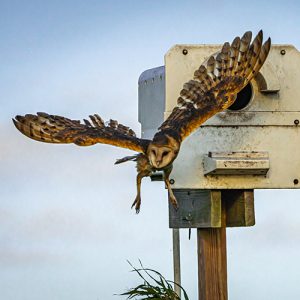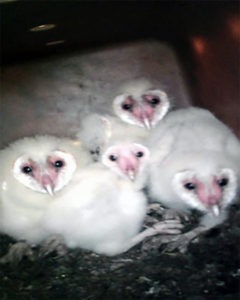Barn owl’s productivity as nature’s rodenticide is something that those in the farming and agricultural sectors have long been familiar with. Today, in celebration of International Owl Awareness Day, we are sharing a few ways that owls have helped farmers.
In the middle of COVID, a local fair board had discussed hiring someone to come in and eradicate pigeons in the livestock barn areas. The flying rodents left equipment, pens, and flooring coated in feathers, bird dust, and droppings — and, unfortunately, they needed to go. After pricing a specialist, board members decided it would be too costly to hire someone, so the 4-H and FFA youth did precisely what they do every year — get to work cleaning out the barn before fair time.
Much to everyone’s surprise, when they arrived, they found that instead of excessive bird droppings, owl pellets and feathers were all that was left of the once-well-established pigeon population. Also, hovering in the barn aisles was a pair of barn owls! Youth members received an excellent wildlife lesson and enjoyed the spoils of the barn owl’s work, and they learned about how other producers are using owls in their operations.
»Related: Best rat poison options for your home and farm
In addition to helping 4-H and FFA members clean out fair barns, owls are also an excellent, natural tool for producers looking to reduce the need for chemical control of rodents in their operation. Pest control is a cornerstone component to growing healthy and productive crops, and barn owls may be just the tool for the job. A family of five to six owls can eat over 3,000 pests during a single growing season.
Wild barn owls can be encouraged to roost in and near farms with the availability of roosting and nesting places.

Florida Crystals is a company helping to encourage and establish barn owl populations on farms. The company’s research and development department includes 30 scientists, whose goal is to search for more sustainable, eco-friendly farming techniques. One such example is the company’s barn owl program, developed by the University of Florida.
Fifteen years ago, the company began working with Dr. Richard Reid at the University of Florida. In 2017, 20 owl boxes were built on Florida Crystals’ organic farms to attract the birds. Those farms are now deploying these feathered farm helpers on their operations in Florida.
Currently, more than 1,250 owls are living in custom-built owl boxes on network farms, hunting pests at night. Now, Florida Crystals is doubling its owl network — making them the largest barn owl network in the world.
The owl’s presence negates the farmer’s ability to utilize rodenticides, but that’s just the tip of the iceberg. Thanks to the owl’s help, they don’t need them. Farmers in the network are primarily located in Palm Beach County or south of Lake Okeechobee in the Everglades. The barn owls are helping control pests in sugarcane, rice, and vegetable crops.

The producers are also working to increase biodiversity, incorporating nature into farming practices. Cover crops are planted to build nutrients in the soil. Rice is often grown because of its need for 80 growing days underwater. Water-logged fields eliminate weeds and protect the land from oxidation.
Florida Crystals conducts biannual owl census, counting owls in October and in March. These dates are specifically chosen due to the owl’s migration patterns. They have found that 50 to 60 percent of boxes full in September are filled at a 97 percent rate in March. Box conditions and food supplies are also regularly monitored.

So, on International Owl Awareness Day, be sure to give a hoot about any barn owls you have roaming your farmland this year.


